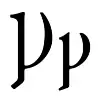| Ꝩ | |
|---|---|
| Ꝩ ꝩ | |
 | |
| Usage | |
| Writing system | Latin script |
| Type | Alphabetic and Logographic |
| Language of origin | Old Norse language |
| Phonetic usage | [u] [v] [w] /vɛnd/ |
| Unicode codepoint | U+A768, U+A769 |
| History | |
| Development | ᚹ
|
| Time period | ~800 to ~1200 |
| Descendants | None |
| Sisters | Ƿ ƿ |
| Transliteration equivalents | u, v, w |
| Other | |
| Other letters commonly used with | u, v, w |
| Writing direction | Left-to-right |
Vend (Ꝩ, ꝩ) is a letter of Old Norse. It was used to represent the sounds /u/, /v/, and /w/.
It was related to and probably derived from the Old English letter Wynn of the Runic alphabet (ᚹ) and later the Latin alphabet (Ƿ ƿ), except that the bowl was open on the top, not being connected to the stem, which made it somewhat resemble a letter Y. It was eventually replaced with v or u for most writings.
Vend in Unicode and HTML entities
The upper and lowercase Vend were standardized in April 2008 as part of the Latin Extended-D block of Unicode 5.1[1]
| Preview | Ꝩ | ꝩ | ||
|---|---|---|---|---|
| Unicode name | LATIN CAPITAL LETTER VEND | LATIN SMALL LETTER VEND | ||
| Encodings | decimal | hex | dec | hex |
| Unicode | 42856 | U+A768 | 42857 | U+A769 |
| UTF-8 | 234 157 168 | EA 9D A8 | 234 157 169 | EA 9D A9 |
| Numeric character reference | Ꝩ | Ꝩ | ꝩ | ꝩ |
References
- ↑ "Unicode Utilities: Character Properties". util.unicode.org. Retrieved 2022-11-03.
This article is issued from Wikipedia. The text is licensed under Creative Commons - Attribution - Sharealike. Additional terms may apply for the media files.